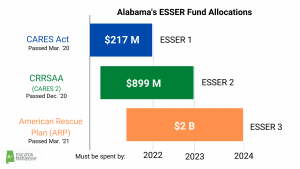Nationwide, public schools are receiving an unprecedented influx in federal funds to address the challenges resulting from the COVID-19 pandemic. Over the course of three rounds, Alabama schools will receive a grand total of $3.14 billion dollars, an unparalleled figure. This is a moonshot moment for our state’s public education system to increase academic outcomes for all students and address long-standing inequities. It will be critical that we spend these funds in a targeted, data-driven, and student-centered way.
Today, we’re launching COVID School Spending, our new blog series exploring topics related to COVID-19 federal funds for schools. We will be sharing evidence-based best practices and resources, highlighting how districts are using these funds across Alabama, elevating advice from policy experts, and much more! In addition, we will be tracking how districts are utilizing their federal funds to ensure this information is accessible to the public.
In our first post of the series, we break down each of the three rounds of Elementary and Secondary School Emergency Relief (ESSER) funding, and how both local districts and the Alabama State Department of Education are able to use these funds.

For a more detailed timeline of ESSER funds, click here.
ESSER I Funding
The Coronavirus Aid, Relief, and Economic Security, or CARES Act, the first round of federal COVID-19 relief funds for states, passed in March 2020, and provided $216 million to Alabama schools as part of the ESSER I fund. At least 90%, or approximately $195 million of this funding was required to be sent directly to local districts, while the Alabama State Department of Education (ALSDE) could keep 10% ($21 million). Because this portion of the money was allocated at the very beginning of the pandemic, the intent was to prepare and equip students and teachers for remote learning and pandemic learning. Districts were allowed to use their portion of the funds for:
- COVID-19 safety, Sanitation, and Personal Protective Equipment (PPE) supplies
- Technology, such as laptops, tablets, and wifi hotspots
- Professional Development for educators to teach remotely
- Mental Health Services
- Summer and Afterschool Programs*
The ALSDE used its allocated 10% to provide grants to districts for virtual instruction resources and updated its data reporting system. This money must have been spent by December 2020.
ESSER II Funding
The Coronavirus Response and Relief Supplemental Appropriations Act (commonly known as CARES II) was the second COVID-19 federal relief bill passed in December of 2020 and sent a second round of funding to states and districts. This time, Alabama received $899 million, with $809 million (90%) going directly to local school districts and 10% going to the ALSDE. This time, districts were allowed to spend their money on:
- Instructional materials
- Professional Development for teachers
- Assessments to gauge where students were in their learning
- Remediation & Enrichment Programs
- Family Support Resources
- Salary & Benefits for Staff*
- Facility Improvements and Repairs
ALSDE used its 10% to provide school districts with grants for summer reading camps for grades K-3, which are required to be provided to struggling readers in the Alabama Literacy Act, professional development for the newly-passed English Language Arts and Math Courses of Study, and reading and math assessments for grades 4-8. This $899 million must be spent by September 2023.
ARP ESSER Funding
The American Rescue Plan, the third round of COVID-19 relief for states, was passed in March 2021. Alabama is receiving $2.02 billion dollars from this third installment of education funds. Like the last two rounds of funding, 90% of the state’s funding is required to go directly to local school districts to accelerate learning for Alabama students. Districts are required to spend at least 20% of their funding on strategies to address learning loss during the pandemic, such as high-quality summer and afterschool programs or other strategies. (You can read our report on how summer and afterschool programs can help students recover from pandemic effects on learning here.) To read more about allowable uses of ARP ESSER funds, click here.
To find out how much your district received in the 2nd and 3rd rounds of ESSER funding, go to this site and click on Alabama.
Have any questions or topics you want us to address in the blog series? Submit them here! To learn more about our programs and support our work, please visit our website aplusala.org.
*This information came from the state’s ARP ESSER Plan. You can read the full plan here or view the information on funding amounts and uses here.
________________________________________________
Read the Full COVID School Spending Series:
Part 1: COVID School Spending: A Series on Investing for Student Success – Outlines how each of the different rounds of federal COVID school relief funds can be used (ESSER I, ESSER II, ARP)
Part 2: Summarizing Alabama’s State ARP Plan – Breaks down the different ways the Alabama State Department of Education is spending their allocation of American Rescue Plan (ARP) funds
Part 3: New Federal Funding to Expand Internet Access – Explains what the Emergency Connectivity Fund is for schools and how they can apply to receive funding

0 Comments on "COVID School Spending: A Series on Investing for Student Success"